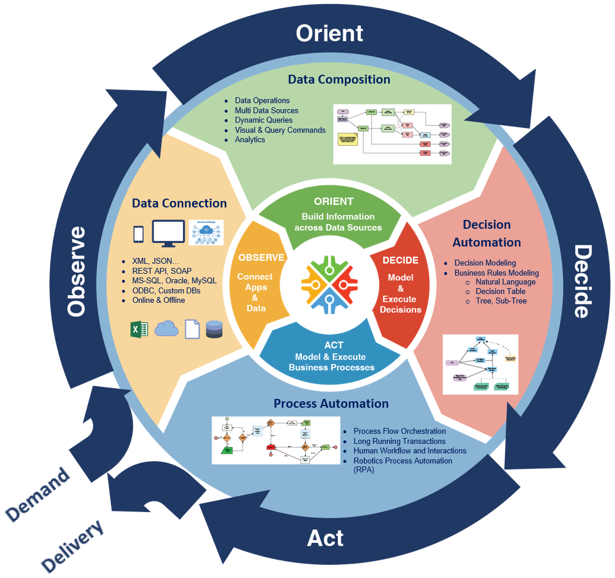Decisions are at the heart of every business transaction. That’s why it is crucial to make the right decision at the right moment in time. In high turnover environments this can be an issue, as new staff need constant monitoring as they ‘learn the ropes’. This can lead to a significant deficit in efficiency and customer satisfaction.
To counter this problem, we advocate what we call a ‘Decision-Centric Approach’, which is designed to address the business challenge by enabling innovative technology in those crucial ‘moments of truth’. This is nothing to do with making massive investments in machine learning, expert systems, business rules, RPA, analytics or other solutions with a view to improving business outcomes and reducing operational costs. Rather, it is a question of explicitly defining the context of the business transaction and any related decisions. This is what allows the business to take advantage of whatever technology has been adopted.
The Decision-Centric Approach brings People, Rules, Data and Processes together and empower organisations to increase business agility. The Decision-Centric Approach will explicitly define the context of the transaction and any related decisions.

Modeling the Decision
Take the example shown in the Decision Requirement Document (DRD) shown below. This demonstrates how a car premium can be calculated.

Each blue box in the diagram above represents a decision to be made. Regardless of the technology used, each decision in this model can be implemented. The decision hierarchy shown here demonstrates both the relationship and dependencies between decisions, while also putting the results of every decision together to reach a final result.
OODA Loop – Decision Cycle
The observer-orient-decide-act (OODA) decision cycle allows you to ensure that the Decision Centric Approach uses moments of truth in everyday business transactions in order to recommend explicitly defined decisions.
Observe: Observing and taking into account new information about our changing environment and competition. Connecting and accessing data and information in the moment, which can be incomplete and imperfect. What is important, what can be ignored and how do you establish these facts quickly?
Orient: Orientation shapes the way we observe, the way we decide and the way we act. It brings perspective into the information that has been gathered in order to create a context for decision-making. The goal of orientation is to create a more accurate model of reality with which to make better decisions and take better actions.
Decide: Models the decisions to be made in the business moment, explicitly defined business decisions, their relationships and dependencies. By executing the decisions, the results are created and ready for the next part.
Act: Allows actions to be taken based on decision outcomes. A decision might have multiple answers, therefore testing, optimizing and creating new data for the cycle as input to Observe is part of the Act.

While the Decision-Centric approach is guaranteed to realise organizational efficiency, it also helps to ensure that based on customer needs, the right decision is made at the right time. This enable organizations to provide personalized and fully customized products and services to their customers through the implementation of customer-centric processes. This approach to selling and supporting products and services is a true business differentiator.
Conclusion
A Decision-Centric Approach allows an organization to adapt and learn rapidly. It increases business agility. It creates a feedback loop and defines business decisions at those crucial 'moments of truth'. Decisions can then be executed using AI, Machine Learning, Business Rules and so on. The key component is to understand these decisions using a framework that puts the decisions into the context of these business moments, which in turn enables the business to adapt rapidly.
In summary, before automating your operational decision-making process, ask yourself the following questions:
1. What routine decisions do we need to make about our customer?
2. What are the circumstances that surround each of these decisions?
3. What rules can we apply as a result of these circumstances?
4. What actions can we take as a result of these rules?
Once you have defined the actions that lend themselves to automation, you can develop the solutions that will ultimately contribute enormously to your company’s bottom line.
Author: Arash Aghlara, Founder & CTO, Flexrule